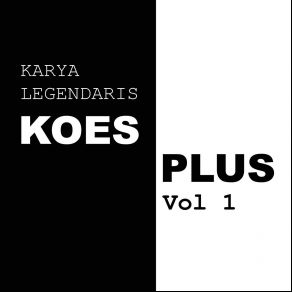Karya Legendaris Koes Plus, Vol. 1
Download links and information about Karya Legendaris Koes Plus, Vol. 1 by Koes Plus. This album was released in 1969 and it belongs to World Music, Pop genres. It contains 22 tracks with total duration of 01:07:38 minutes.

|
|
|---|---|
| Artist: | Koes Plus |
| Release date: | 1969 |
| Genre: | World Music, Pop |
| Tracks: | 22 |
| Duration: | 01:07:38 |
| Buy it NOW at: | |
| Buy on iTunes $7.99 | |
Tracks
[Edit]| No. | Title | Length |
|---|---|---|
| 1. | Pilih Satu | 4:00 |
| 2. | Bersama Lagi | 3:19 |
| 3. | Kereta Api Pagi | 3:00 |
| 4. | Diana (Versi 2) | 3:02 |
| 5. | Panggillah Namaku | 2:58 |
| 6. | Nusantara 78 | 3:18 |
| 7. | Dewi Rindu | 2:37 |
| 8. | Andaikan Kau Datang | 3:20 |
| 9. | Bunga Ditepi Jalan | 3:23 |
| 10. | Pelangi | 2:30 |
| 11. | Layang Layang | 2:52 |
| 12. | Diakhir Yang Dini | 2:34 |
| 13. | Hati Yang Tulus | 5:04 |
| 14. | Sepi Dan Hampa | 2:35 |
| 15. | Maafkan Aku | 2:39 |
| 16. | Menyusuri Jalan | 2:50 |
| 17. | Why Do You Love Me | 3:22 |
| 18. | Mari Mari | 3:48 |
| 19. | Kr. Pertemuan | 2:26 |
| 20. | Angin Laut | 2:31 |
| 21. | Harapanku | 2:46 |
| 22. | Selamat Tinggal | 2:44 |
Details
[Edit]Koes Bersaudara (in English, "The Koes Brothers") were often called "the Indonesian Beatles," both as a testament to their skills and the obvious influence of the Fab Four on their music, and given how the Beatles' work would grow and change over the course of the '60s, it makes sense that Koes Bersaudara would evolve as well. Drummer Nomo Koeswoyo left the act in 1968, and with the addition of new percussionist Kamuri, the other Koeswoyo Bothers — Tonny, Yon, and Yok — changed the group's name to Koes Plus, and the two albums this new version of the band recorded in 1969 and 1970 reflect a more ambitious and mature musical outlook. Sublime Frequencies, who had previously released an excellent collection of Koes Bersaudara's recordings, issued this two-fer CD featuring the first two Koes Plus albums, and Dheng Dheng Plas, while still falling within the boundaries of Beat-era rock & roll; these discs make clear the combo was expanding its horizons. "Bergembira (Have Fun)" sounds like some Sir Douglas Quintet albums had made their way to Indonesia, "Tiba Tiba Aku Menangis (Suddenly I Cried)" recalls the darker moments on Rubber Soul and Revolver, and much of the album shows off a laid-back folk-rock influence, with the band's fine harmonies dovetailing nicely with the more contemplative approach. By comparison, Koes Plus, Vol. 2 (which was their first album in stereo) is a far more ambitious and eclectic set, opening with the reggae-influenced "Lagu Dalam Impian (Song in a Dream)" and moving through hard rock ("Pent Juri Hati [Heart Stealer]"), moody ballads ("Kisah Sedih Di Hari Minggu [Sunday Sad Story]"), a prog-influenced number complete with vibes ("Kau Tinggalkan Aku [You Left Me]"), several gentle psychedelic numbers, and what sounds like the first Indonesian interpretation of British folk ("Mengapa Kau Sedih [Why Were You Sad]"). The keyboards that were moving forward in the Koes Plus sound on the first album take a much bigger role on Koes Plus, Vol. 2, and while the recording sounds primitive, the group were clearly attempting to take greater advantage of the possibilities of the studio, even if they didn't have a setup that could match Abbey Road in London. In some respects, this disc is less immediately engaging than the Koes Bersaudara collection, as Koes Plus were traveling in a direction that was more ambitious and less hooky, but this is still solid and imaginative music that should '60ss.